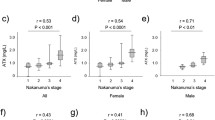Abstract
Background
Primary biliary cirrhosis (PBC), characterized by cholangitis and loss of intrahepatic small bile ducts, predominantly affects middle-aged females. We have reported that fractalkine expression associated with chronic inflammation is observed in the damaged bile ducts and periductal vessels of PBC patients, which is closely associated with chronic cholangitis.
Aims
We investigated the association between serum fractalkine levels and clinicopathological findings in PBC patients.
Methods
Liver biopsy specimens before ursodeoxycholic acid treatment and serum samples at the time of liver biopsy and 1 and 2 years after treatment were obtained from 68 PBC patients (M/F = 14/54). Serum fractalkine levels were measured by enzyme-linked immunosorbent assay, and their association with clinicopathological findings (liver function data, autoantibodies, cholangitis activity, hepatitis activity, fibrosis, bile duct loss, and orcein-positive granules) was analyzed.
Results
Serum fractalkine levels were in the range of 0.1–33.2 ng/ml (average, 3.2 ng/ml). They were increased in PBC patients with high degrees of cholangitis activity, a mild degree of hepatitis activity, fibrosis, orcein-positive granules, and early stages. In cases with high serum fractalkine levels, those who exhibited good biochemical responses to treatment mostly showed improved serum fractalkine levels after treatment.
Conclusion
Serum fractalkine levels of PBC patients were high in cases with marked cholangitis activity at early stages. In addition, they closely correlated with the effect of therapy, indicating that fractalkine plays a role in the pathogenesis of initial cholangitis in early stage PBC and consequent chronic cholangitis. Thus, our results suggest that fractalkine is a good candidate for molecular-targeted treatment.




Similar content being viewed by others
Abbreviations
- ADAM:
-
A disintegrin and metalloprotease
- AMA:
-
Anti-mitochondrial antibody
- CNSDC:
-
Chronic nonsuppurative destructive cholangitis
- IBD:
-
Inflammatory bowel disease
- PBC:
-
Primary biliary cirrhosis
- RA:
-
Rheumatoid arthritis
- TLR:
-
Toll-like receptor
- UDCA:
-
Ursodeoxycholic acid
- ULN:
-
Upper limit of normal
References
Bourd-Boittin K, Basset L, Bonnier D, L’Helgoualc’h A, Samson M, Theret N. CX3CL1/fractalkine shedding by human hepatic stellate cells: contribution to chronic inflammation in the liver. J Cell Mol Med. 2009;13:1526–1535.
Jones BA, Beamer M, Ahmed S. Fractalkine/CX3CL1: a potential new target for inflammatory diseases. Mol Interv. 2010;10:263–270.
Nishimura M, Kuboi Y, Muramoto K, Kawano T, Imai T. Chemokines as novel therapeutic targets for inflammatory bowel disease. Ann N Y Acad Sci. 2009;1173:350–356.
Nakanuma Y, Ohta G. Histometric and serial section observations of the intrahepatic bile ducts in primary biliary cirrhosis. Gastroenterology. 1979;76:1326–1332.
Shimoda S, Ishikawa F, Kamihira T, et al. Autoreactive T-cell responses in primary biliary cirrhosis are proinflammatory whereas those of controls are regulatory. Gastroenterology. 2006;131:606–618.
Shimoda S, Miyakawa H, Nakamura M, et al. CD4 T-cell autoreactivity to the mitochondrial autoantigen PDC-E2 in AMA-negative primary biliary cirrhosis. J Autoimmun. 2008;31:110–115.
Shimoda S, Nakamura M, Ishibashi H, Hayashida K, Niho Y. HLA DRB4 0101-restricted immunodominant T cell autoepitope of pyruvate dehydrogenase complex in primary biliary cirrhosis: evidence of molecular mimicry in human autoimmune diseases. J Exp Med. 1995;181:1835–1845.
Shimoda S, Nakamura M, Ishibashi H, et al. Molecular mimicry of mitochondrial and nuclear autoantigens in primary biliary cirrhosis. Gastroenterology. 2003;124:1915–1925.
Isse K, Harada K, Zen Y, et al. Fractalkine and CX3CR1 are involved in the recruitment of intraepithelial lymphocytes of intrahepatic bile ducts. Hepatology. 2005;41:506–516.
Shimoda S, Harada K, Niiro H, et al. Interaction between Toll-like receptors and natural killer cells in the destruction of bile ducts in primary biliary cirrhosis. Hepatology. 2011;53:1270–1281.
Harada K, Ohira S, Isse K, et al. Lipopolysaccharide activates nuclear factor-kappaB through toll-like receptors and related molecules in cultured biliary epithelial cells. Lab Invest. 2003;83:1657–1667.
Nakanuma Y, Zen Y, Harada K, et al. Application of a new histological staging and grading system for primary biliary cirrhosis to liver biopsy specimens: Interobserver agreement. Pathol Int. 2010;60:167–174.
Rigopoulou EI, Davies ET, Pares A, et al. Prevalence and clinical significance of isotype specific antinuclear antibodies in primary biliary cirrhosis. Gut. 2005;54:528–532.
Invernizzi P, Selmi C, Ranftler C, Podda M, Wesierska-Gadek J. Antinuclear antibodies in primary biliary cirrhosis. Semin Liver Dis. 2005;25:298–310.
Nakamura M, Kondo H, Mori T, et al. Anti-gp210 and anti-centromere antibodies are different risk factors for the progression of primary biliary cirrhosis. Hepatology. 2007;45:118–127.
Nakamura M, Komori A, Ito M, et al. Predictive role of anti-gp210 and anticentromere antibodies in long-term outcome of primary biliary cirrhosis. Hepatol Res. 2007;37:S412–S419.
Nakamura M, Shimizu-Yoshida Y, Takii Y, et al. Antibody titer to gp210-C terminal peptide as a clinical parameter for monitoring primary biliary cirrhosis. J Hepatol. 2005;42:386–392.
Itoh S, Ichida T, Yoshida T, et al. Autoantibodies against a 210 kDa glycoprotein of the nuclear pore complex as a prognostic marker in patients with primary biliary cirrhosis. J Gastroenterol Hepatol. 1998;13:257–265.
Kumar D, Tandon RK. Use of ursodeoxycholic acid in liver diseases. J Gastroenterol Hepatol. 2001;16:3–14.
Acknowledgments
This work was supported by grant No. 23590393 from the Ministry of Education, Culture, Sports, Science and Technology of Japan (K.H.) and by Health and Labour Sciences Research Grants for the Research on Measures for Intractable Diseases (Chief Tsubouchi, M.D.).
Conflict of interest
None.
Author information
Authors and Affiliations
Corresponding author
Rights and permissions
About this article
Cite this article
Harada, K., Kakuda, Y., Nakamura, M. et al. Clinicopathological Significance of Serum Fractalkine in Primary Biliary Cirrhosis. Dig Dis Sci 58, 3037–3043 (2013). https://doi.org/10.1007/s10620-013-2734-6
Received:
Accepted:
Published:
Issue Date:
DOI: https://doi.org/10.1007/s10620-013-2734-6




